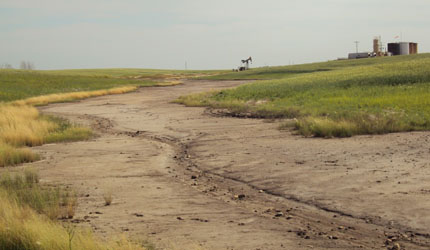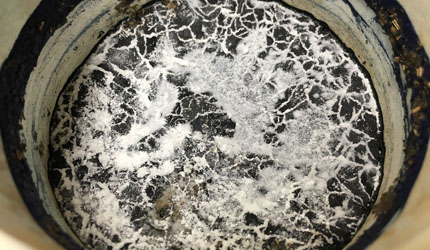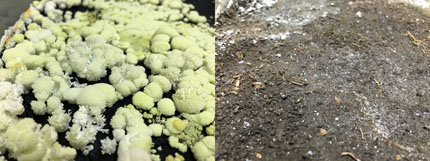Soil Science Society of America
5585 Guilford Road • Madison, WI 53711-5801 • 608-273-8080 • Fax 608-273-2021
www.soils.org
Twitter | Facebook
NEWS RELEASE
Contact: Hanna Jeske, Associate Director of Marketing and Brand Strategy, 608-268-3972, hjeske@sciencesocieties.org
Solution blooming for fracking spills?
Sept. 28, 2016 - North Dakota's oil boom can have a salty side-effect. Wastewater from oil drilling and hydraulic fracturing – or fracking – is often laden with salts and can spill, contaminating soils. In 2014, for example, 42 such brine spills per week, on average, were recorded in North Dakota.
 Brine spills introduce so much salt into the soil that local vegetation cannot survive. The salts stay around for decades, even centuries. That prevents growth of plants, putting valuable land out of production.
Brine spills introduce so much salt into the soil that local vegetation cannot survive. The salts stay around for decades, even centuries. That prevents growth of plants, putting valuable land out of production.
In a recent study, researchers at North Dakota State University tested a method that extracted a large percentage of the salt present in soils contaminated by brine spills.
Researchers applied a chemical – ferric hexacyanoferrate – to samples of brine-contaminated soils in the laboratory. After seven days, 29-57% of the salts were pulled to the surface for easier removal, depending on the type of soil being tested.
The salt crystals formed on the soil surfaces “were high in water content and very easy to remove,” says Aaron Daigh, one of the researchers. This technique still needs to be field-tested, but shows promise as a quick and simple way to clean up salt-contaminated soils.
“The traditional methods used to remove salt from soils contaminated by brine spills either take too long or involve removing the soil itself,” says Daigh. Excavating contaminated soil and moving it to designated areas only relocates the problem. Salts remain in those soils.
Other methods attempt to push the salts below the level plant roots can reach. But that's often a temporary fix. The salts can dissolve in groundwater and move back up through the soil.
“N o one has tried to bring the salt up, out of the ground, and harvest it,” says Daigh. That would be a permanent remediation strategy, but in order to make the idea work, researchers had to overcome one major obstacle.
o one has tried to bring the salt up, out of the ground, and harvest it,” says Daigh. That would be a permanent remediation strategy, but in order to make the idea work, researchers had to overcome one major obstacle.
“As water evaporates from the soil, salts get deposited in the soil pores,” says Daigh. “The deposited salt can form a hard, cemented crust, which is very difficult to remove.” Daigh's first order of business was to find a way to stop this salty crust from forming.
While searching for ways to do that, Daigh and his colleague came across a chemical that piqued their curiosity. “It was being used in Europe, to keep road salt from affecting old heritage buildings,” says Daigh.
When the researchers applied this chemical to salt-contaminated soils in the laboratory, it made salts crystallize out of the soils and 'bloom' out on the surface. Within seven days of application, 29, 46, and 57% of salts from sandy loam, loam, and silty clay soils, respectively, had bloomed on their surfaces.
One concern with introducing any chemical into the environment is safety. “Toxicity of this chemical towards humans and the environment is relatively minimal,” says Daigh. He describes the chemical as “extraordinarily stable.”
When it does decompose it yields hydrogen -- and free-cyanides, which can be toxic. But Daigh says that the chemical breaks down quite slowly – taking decades or even centuries under most soil conditions. This slow breakdown can allow microbes to metabolize the cyanides and render them relatively  harmless.
harmless.
“Moreover, ferric hexacyanoferrate is used here as just an example,” says Daigh. “Other chemicals with low-toxicity reaction products may produce similar results.”
Daigh and his colleagues are in the process of field-testing this chemical. “We need to find out how much to apply, and how often to apply it,” he says. They are also exploring ways to apply the chemical indirectly and reuse it over several applications.
Read more about Daigh’s research in Agricultural and Environmental Letters. This research is funded by the North Dakota State University Agricultural Experiment Station.
Agricultural & Environmental Letters is gold open access journal, publishing communications-length, broad-reaching, transformative, and timely commentaries and research letters on major scientific, policy, and economic issues that span the entire range of the agricultural and environmental sciences.